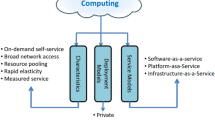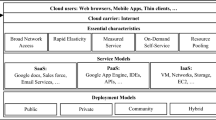Abstract
Service-oriented architecture (SOA) provides a powerful paradigm to compose service processes using individual atomic services. When running a service process, SOA needs an efficient and effective mechanism to detect service delivery failures and to identify the individual service(s) that causes the problem. In this research, we study the model of accountability to detect, diagnose, and defuse the real cause of a problem when service errors (such as incorrect result or SLA violation) occur in a service process. Our approach leverages Bayesian networks to identify the most likely problematic services in a process and selectively inspect those services. An evidence channel selection algorithm is designed to specify which services in a service network should be monitored to achieve the best cost-efficiency. We model the channels selection as the classic facilities location problem. We also adopt a continuous knowledge learning process to manage the dynamic nature of SOA. The performance study shows that our proposed accountability mechanism is effective on identifying the root cause of problems and can achieve significant cost savings: with 50% of services’ outputs monitored as evidence, the comprehensive diagnosis correctness can reach 80% after only 20% of services are inspected.
Similar content being viewed by others
References
Bichler M, Lin KJ (2006) Service-oriented computing. IEEE Computer 39(3):99–101
Huhns MN, Singh MP (2005) Service-oriented computing: Key concepts and principles. IEEE Internet Computing
Curbera F, Goland Y, Klein J, Leymann F, Roller D, Thatte S, Weerawarana S (2003) Business process execution language for web services, version 1.1. http://www-106.ibm.com/ developerworks/webservices/library/ws-bpel
Ross-Talbot S, Fletcher T (2006) Web services choreography description language: Prime. http://www.w3.org/TR/ ws-cdl-10-primer/
Neumann PG (2006) Risks relating to system compositions. Commun of ACM 49(7)
Yu T, Lin KJ (2005) Service selection algorithms for composing complex services with end-to-end QoS constraints. Proc. 3rd International Conference on Service Oriented Computing (ICSOC2005), The Netherlands Amsterdam
Yu T, Lin KJ (2005) Adaptive algorithms for finding replacement services in autonomic distributed business processes. The 7th International Symposium on Autonomous Decentralized Systems, Chengdu, Jiuzhaigou, China
Lin KJ, Hsu JY, Zhang Y, Yu T (2006) A distributed reputation broker framework for web service applications. J E-Commerce Res 7(3):164–177
Lin KJ, Lu H, Yu T, Tai CE (2005) A reputation and trust management broker framework for web applications. IEEE Conference on e-Technology, e-Commerce and e-Service (EEE’05), 262–269
Horsch K (1996) Results-based accountability systems: Opportunities and challenges. The Evaluation Exchange II(1) http://www.gse.harvard.edu/hfrp/eval/issue3/theory1.html
Acharya M, Kulkarni A, Kuppili R, Mani R, More N, Narayanan S, Patel P, Schuelke KW, Subramanian SN (2005) SOA in the real world experiences. Proceedings of the 3rd International Conference on Service-Oriented Computing 437–449
Ponnekanti SR, Fox A (2002) SWORD: A developer toolkit for web service composition. 11th World Wide Web Conference, Honolulu, Hawaii
Yu T, Lin KJ (2005) A broker-based framework for QoS-aware web service composition. In: IEEE International Conference on e-Technology, e-Commerce and e-Service (EEE-05), Hong Kong, China
Cormen TH, Leiserson CE, Rivest RL, Stein C (2001) The set-covering problem. Introduction to algorithms, second edition, MIT Press, McGraw-Hill, pp 1033–1038
Zhang Y, Lin KJ, Klefstad R (2006) DIRECT: arobust distributed broker framework for trust and reputation management. IEEE Conference on e-Technology, e-Commerce and e-Service (EEE’06)
Pearl J (1988) Probabilistic reasoning in intelligent systems. Morgan Kaufmann, San Mateo
Heckerman D, Breese JS, Rommelse K (1995) Decision-theoretic troubleshooting. Commu ACM 38(3):49–57
Lerner U, Parr R, Koller D, Biswas G (2000) Bayesian fault detection and diagnosis in dynamic systems. AAAI/IAAI, pp 531–537
Korb KB, Nicholson AE (2004) Bayesian artificial intelligence. Chapman & Hall/CRC, London UK
Jensen FV (2001) Bayesian networks and decision graphs. Springer, Heidelberg
Nilsson NJ (1998) Artificial intelligence: a new synthesis. Morgan Kaufmann Publishers, San Francisco
DSL (2006) SMILE (structural modeling, inference, and learning engine). Decision Systems Laboratory(DSL), School of Information Sciences, University of Pittsburgh, Pittsburgh, http://genie.sis.pitt.edu/
Jensen FV, Liang J (1994) drHugin: a system for value of information in bayesian networks. Proceedings of the 1994 Conference on Information Processing and Management of Uncertainty in Knowledge-Based Systems, pp 178–183
Jensen FV, Liang J (1992) A system for hypothesis driven myopic data request. Technical Report R-92-2021, Department of Mathematics and computer Science, Aalborg University, Aalborg
Arya V, Garg N, Khandekar R, Munagala K, Pandit V (2001) Local search heuristic for k-median and facility location problems. ACM Symposium on Theory of Computing, pp 21–29
Charikar M, Guha S, Tardos E, Shmoys DB (1999) A constant-factor approximation algorithm for the k-median problem (extended abstract). ACM Symposium on Theory of Computing, pp 1–10
Ide JS, Cozman FG (2002) Generating random bayesian networks. Proceedings on 16th Brazilian Symposium on Artificial Intelligence (SBIA 2002), Advances in Artificial Intelligence, Springer, Berlin, pp 366–375
Wang G, Wang C, Chen A, Wang H, Fung C, Uczekaj S, Chen YL, Guthmiller W, Lee J (2005) Service level management using QoS monitoring, diagnostics, and adaptation for networked enterprise systems. EDOC Enterprise Computing Conference, 2005 Ninth IEEE International, pp 239–248
Ardissono L, Console L, Goy A, Petrone G, Picardi C, Segnan M (2005) Enhancing web services with diagnostic capabilities. Third IEEE European Conference on Web Services (ECOWS 2005)
Lee G (2006) CAPRI: a common architecture for autonomous, distributed diagnosis of internet faults using probabilistic relational models. In: the First Workshop on Hot Topics in Autonomic Computing (HotAC I) in conjunction with the 3rd IEEE International Conference on Autonomic Computing (ICAC-06)
Krishnan R, Peters J, Padman R, Kaplan D (2005) On data reliability assessment in accounting information systems. Inform Systems Res 16:307–326
Author information
Authors and Affiliations
Corresponding author
Rights and permissions
About this article
Cite this article
Zhang, Y., Lin, KJ. & Hsu, J.Y.J. Accountability monitoring and reasoning in service-oriented architectures. SOCA 1, 35–50 (2007). https://doi.org/10.1007/s11761-007-0001-4
Received:
Revised:
Accepted:
Published:
Issue Date:
DOI: https://doi.org/10.1007/s11761-007-0001-4




